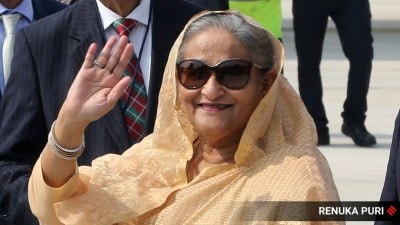Outsider
The Pre-Raphaelites and their stunners,as Dante Gabriel Rossetti called his models,have long been the object of fascination.
The Pre-Raphaelites and their stunners,as Dante Gabriel Rossetti called his models,have long been the object of fascination. Perhaps that is why so little has been written about Ford Madox Brown (1821-93),a painter who,though closely associated with them,never joined their fraternity. With his upbringing and early training in France and Belgium,Brown was always the outsider. Angela Thirlwells Into the Frame,a carefully researched and sympathetic biography of Brown and the four women he loved,helps fill that gap,while making a valuable contribution to the growing literature about women who have figured in the lives of prominent men.
Not that these women were in anyones shade. Out of the four,three were educated and independent-minded,two of them creative in their own right. His pupil,Marie Spartali,impossibly beautiful (pictured at left),intelligent and rich her businessman father was the Greek consul-general in London became a painter of repute. Mathilde Blind,daughter of German political refugees,was a published poet,novelist,translator and biographer. (A portrait is below left.) Browns first wife,his cousin Elizabeth Bromley,whom he married when he was only 19,was also a cultivated woman. All of them related to him as equals,which says as much for him as for them.
Emma Hill,whom Brown married after Elizabeths death,is more elusive. The daughter of a bricklayer,she was uneducated like other wives and models in Browns circle and has left little trace beyond her presence in his paintings. But from the outset,she was clearly a force: a girl as loves me came in and disturbed me,Brown wrote in his diary. She was fun and sexy,the most beautiful duck in existence,he wrote,and despite difficulties he never lost his feeling for her.
Emma drank. Its a wonder more of them didnt. Death shadowed them. Browns first marriage to Elizabeth filled the gap left by the deaths from tuberculosis of his mother and sister,his only sibling. Their first baby died within five days,Elizabeth herself five years later. And so it continued. Daughters from both marriages survived,but sons died,one of them,Nolly,Emmas golden boy,aged 19. Money was often tight. Browns paintings were admired by his fellows,but others often thought them ugly and awkward. He fell into depressions.
Had a mushroom for tea and thought about death, Brown wrote in his diary. A heroic stoicism emerges from these lives. They mourned and yearned in private. Elizabeth urged herself to observe Silence,Order,Moderation and Humility. Brown forbade tears at Nollys funeral. His love for Marie remained unspoken except in secret sonnets. Emma never wrote,but she achieved over time a steady gentleness that could soothe Brown at a word.
In among all this,Ms Thirlwell weaves the stories of Marie and Mathilde,both much younger,and each carrying a huge emotional and intellectual charge. Their feelings for him as an older man were complex,but much of it had to do with his sympathy for them as artists. Ms Thirlwell writes with great thoughtfulness and insight. The only character who seems to have needed a little forcing is Mathilde so admirable in her feminism,so interesting in her political radicalism,so beautiful in her photograph and yet,reading between the lines,so utterly self-absorbed.



- 01
- 02
- 03
- 04
- 05




























